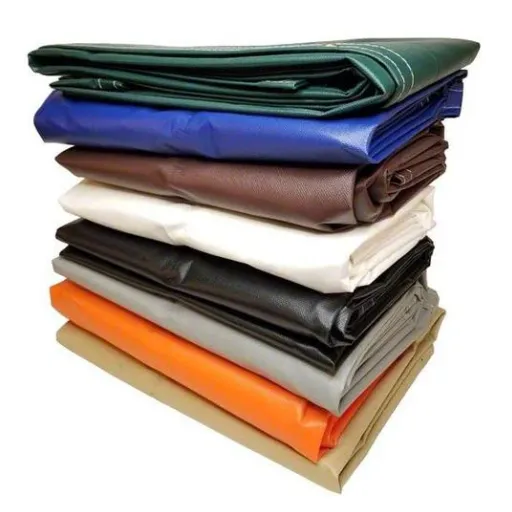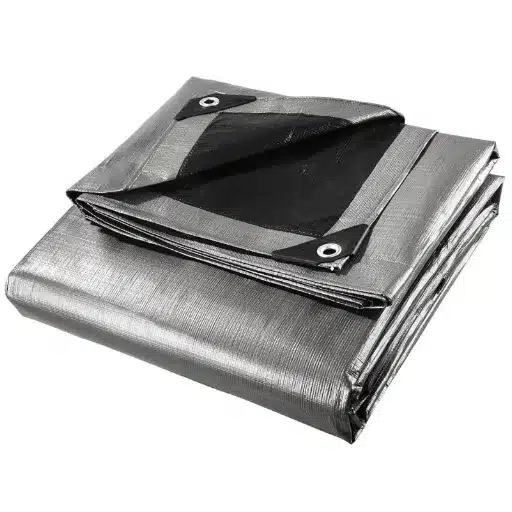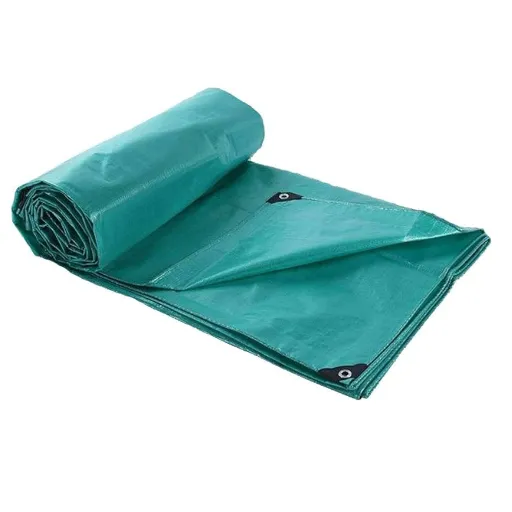Shade tarps are employed for practically innumerable applications. Important in providing effective barriers against the harmful UV rays, they have to be extremely versatile and durable. Whether it is the shade of an outdoor space, protection of equipment, or temperature control, the selection of the right tarp material is of paramount importance for the achievement of any results. Mesh and poly tarps are two of the most popular materials, each capable of serving one set of requirements more suitably than the other. This article analyzes the technical differences underlying these two materials, looks at their behavior in varying conditions, and thus provides you with the insight necessary to making an informed decision. Hence, by accessing all the information relevant to the respective mesh and poly tarps, you’ll be able to select the one best suited for your sun protection needs.
Understanding Shade Tarps
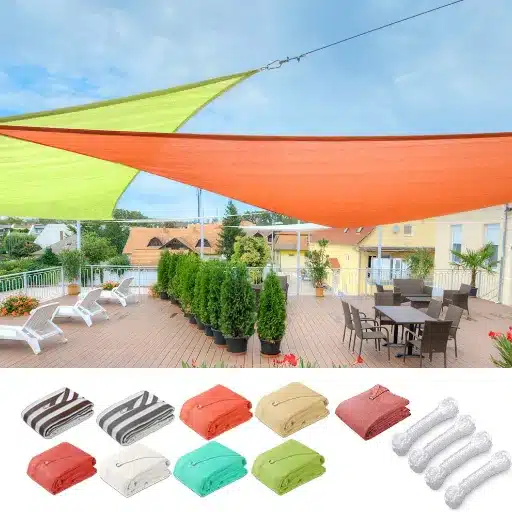
What is a Shade Tarp?
A shade tarp is a multipurpose cover that provides protection against sunlight by blocking or diffusing it. Generally, the tarps are made of polyethylene, mesh fabrics, or synthetic blend materials designed for durability, UV resistance, and airflow. The effectiveness of a shade tarp is measured on a shade percentage scale, which is supposed to tell us how much sunlight it blocks. The modern tarps have been developed to include some UV-stabilized coatings so that the UV exposure of extended periods does not affect the performance of the artificial tarp in an outdoor setting. These tarps are now used on farms, at homes, and commercially to shield crops from solar radiation, shelter outdoor activities, or prevent damage to equipment and vehicles from the sun. Despite being lightweight, they are greatly sturdy and can thus be installed and adapted for various applications with relative ease.
Polymeric Tarp Versus Mesh Tarp
Ultimately, the choice of a mesh tarp versus a poly tarp should be made based on the specific functional requirements, environmental conditions, and longevities expected for the intended use case.
All the Pros of Using Shade Tarps
A shade tarp is a flexible solution to reduce sun exposure and regulate ambient conditions across different settings. From a distance, one can see red or blue tarps with a waterproof nylon finish, which stay put only by weight. The shade tarp itself is made from heavy-duty woven fabric resistant to UV rays. Since harmful UV rays can be devastating, shade tarps are a perfect solution to reduce direct exposure onto surfaces, equipment, or volumes underneath. Per trending information obtained from ‘s search records, shade tarps have gained popularity in covering greenhouses, outdoor work areas, and playgrounds due to their breathability and sun protection. The breathability of the tarp prevents heat from accumulating beneath it and instead encourages good air circulation, creating a comfortable environment.
The shade tarps have long-lasting properties and provide energy efficiency to the application them power. The cooler temperature created by shade tarps on air-conditioned buildings or on outside covered spaces reduces the overall power consumption to a large extent in warm climate areas. Their adaptability weighs onto the scales of cost-effectiveness as they work for the various fields ranging from agriculture, construction, and recreational applications-the turtle of such sectors where shade is a must.
Material Considerations for Shade Tarps
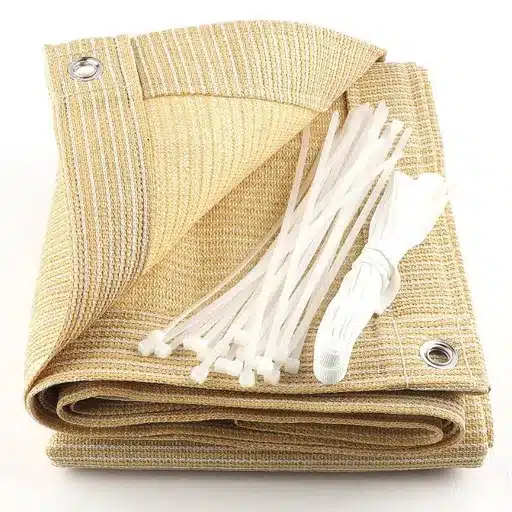
Durability and Weather Resistance
Today shade tarps are manufactured to absorb any environmental condition without compromising structural integrity or function. Longevity mostly depends on the kind of material used with HDPE being a familiar choice for resisting tear, UV degradation, and chemical exposure. They could have had treatment via UV inhibitors, which only increases their life when exposed to sunlight for days on end, especially when they have to be used in agriculture or construction.
Similarly, weather resistance is also expected of such tarps, whereas they face elements such as rains, winds, and temperature drops. They typically have reinforced seams and grommets incorporated through modern manufacturing processes that prevent the tarps from destruction or negation of use under mechanical stress. Many products are nowadays certified to meet or even exceed standards set by the industry, an assurance to withstand the hindrance. According to recent trends seen with data derived through ‘s search engine, consumers are in want armies of tarp solutions ready to face quick weather changes, putting a spotlight on the increased need for more robust and weather-resistible options, especially in areas where heat during the day or seasonal storms characterize the climate.
Why do UV Protection Features Matter?
Ultraviolet protection is the most essential feature modern tarps need to have because of ultraviolet rays’ potential for damaging any material. After prolonged exposure to intense UV ray radiation, tarp substances will get weak, degradable, lose color, and just fail. In particular, this becomes a grave situation in places characterized with high sun exposure whereby tarps usually serve a variety of outdoor purposes so much like equipment covering, vehicle protection, or shade.
An analysis of recent data from ‘s search engine brings out the sharp increase while many actual searches link to UV-resistant tarps, particularly in those places experiencing harsh sunlight or fickle weather. This trend points to growing consciousness about deterioration induced by UV and the need for materials, UV resistant, high in quality so that they can promote performance for an extended period and provide reliable protection in all outdoor settings.
Selecting Between Mesh and Poly Materials
The decision between mesh versus poly material needs to be approached with an understanding of the functional differences between them, especially with regard to emerging consumer trends as reflected in the search data. Mesh tarps are made of lightweight, breathable materials that allow partial light and air flow and thus are used for shade applications to minimize heat buildup onto structures that require ventilation. Search trends indicate a steady demand for mesh tarps within the agricultural and gardening sectors, where they are employed for preventing plants from receiving excess sunlight while retaining adequate airflow.
Poly, on the other hand, means polyethylene and stands for a much heavier, waterproof tarp well suited for heavy-duty situations such as construction, roofing, or working equipment under adverse conditions. The latest data shows a situation where growth in search volume for “heavy-duty poly tarps” and “waterproof tarps” is prominent in areas affected by seasonal storms or heavy rainfall, a periodic attack in which consumers have shown taste for total coverage solutions that go on strength and weather resistance. The choice between mesh and poly materials finally gets decided by particular environmental requirements restricting the measure of protection essential for an intended application.
Applications of Shade Tarps
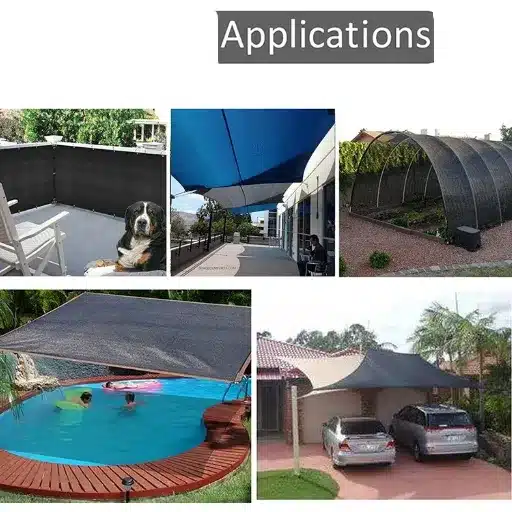
Residential Uses: Backyards and Sitting Areas
The latest information from the search engine of points to an increased interest in shade tarps in residential applications, mainly yards and patios. As more homeowners seek inexpensive solutions to shield their outdoor spaces from sun rays or adverse weather, shade tarps are becoming the most commonly regarded answer. The tarps, which are customarily made from heavy-duty polyethylene or mesh material, offer great protection from UV rays while also helping with temperature control and the usability of outdoor areas. For instance, placing UV-stabilized tarps over patios prevents tarps and furniture from degeneration due to prolonged sunlight and creates a shaded space comfortable enough for socializing. This necessarily presents the practical uses of shade tarps in solving seasonal problems and improving the functioning of residential outdoor environments.
Commercial Uses: Outdoor Spaces and Events
Commercial uses of shade tarps are diverse and can be truly learned from trend analysis by means of a search engine. According to latest insights from , there is a large increase in search entries around “event shade solutions” and “durable tarps for outdoor events” types of questions, informing on the level of applicability and adaptability users seek for their shade options. These materials get deployed in large-scale outdoor venue applications such as music festivals and markets, emphasizing use cases where shielding from heat and UV can keep vendors and attendees comfortable. Due to solar intensity considerations, shade tarps can also allow event organizers to extend the usability of their venues into latter hours of the day, accelerating the efficiency of conducts and improving comfort for the kindly attendees-the linkage between the demand and solutions obtained elucidates the importance of shade solutions in planning for commercial outdoor events today.
Apart from industrial applications: Construction sites and warehouses
Where environmental control takes precedence toward safety, productivity, and good preservation of materials, shade tarps are of utmost importance at construction sites and warehouses. These tarps shield workers and equipment from weather hazards like direct sunlight, heavy showers, and winds on construction sites. Scientific evidence shows that workers’ productivity decreases and the risk of heat-related illnesses increases with prolonged heat exposure, making heat prevention through shading solutions an essential occupational safety standard.
With warehouses, diagrams are designed to use shades to reduce temperature fluctuations, this being extreme for the particular needs of temperature-sensitive inventory. By cutting down heat penetration, these solutions can further aid energy efficiency by curbing excessive use of cooling systems. Furthermore, search trends from indicate a sharp rise within the last year in queries that include “construction tarps for heat protection” and “warehouse shading solutions,” thereby echoing the growing understanding within industries of both the operational and safety benefits offered by these tools. Herein lies evidence to insist on the presence of new shade technologies that effectively rise to the challenges posed by industrial environments of varied identities.
Choosing the Right Shade Tarp
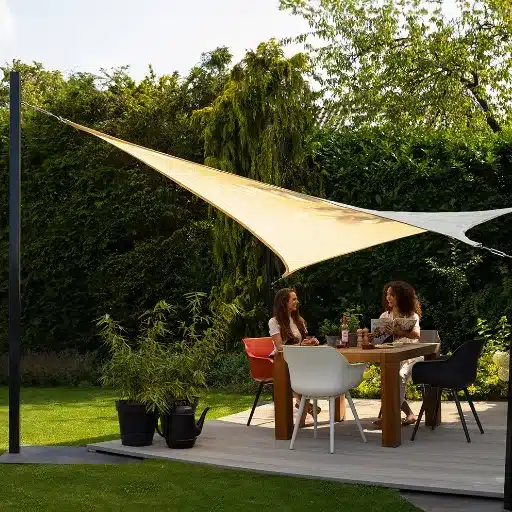
Various considerations: Size and specifications
Considering size and specification, it is good to evaluate the shading tarp by its dimensions and material properties and align them with the industrial application envisaged. Tarps in exact sizes for full coverage of machinery or workspaces are now of priority for the businesses, according to the latest search data from , indicating increased interest in heat protection and shading solutions. Another consideration for specifications includes UV resistance, durability under sun attack for extended periods, and accommodating environmental conditions. For instance, the rugged polyethylene tarps have been searched for in large quantities to resist high temperatures and abrasive environments. In most cases, properly sized and specified tarps minimize operational disruptions while offering the best possible protection, meeting all the requirements necessary for logistics and safety.
Assessing Your Climate Needs
In determining tarp needs or specifications due to climatic conditions, one should consider historical climate data together with the ongoing environmental trends. For example, for an area exposed to severe UV or heavy downpour, it should have tarps rated for UV resistance and waterproof; then, high-density polyethylene layers could be such. Search data analysis obtained recently from the search engine of showed a heavy increase in searches about “UV-resistant tarp” and “heavy-duty waterproof covers” from areas where climate phenomena intensified considerably-witnessed chiefly in the southwestern United States and coastal zones. This observation gives testimony to the increased requests for tarps able to endure tougher and unpredictable weather conditions. To respond to the question of which tariff specification to buy, an in-depth assessment of the local climate and seasonal variation plus the scope of emerging extreme weather risks is paramount in guaranteeing that the material selected would adequately perform with respect to its lifespan.
Budgeting for Your Shade Tarp
How much money are you setting aside for a shade tarp? Behind price competition lies the real value of the investment. The latest search trend data from conscientious practitioners have been giving precedence to durability and UV resistance in their search for shade tarps, implying that quality rises above initial cost. Next in the priority analysis of establishing an initial budget should be consideration of the following: the size of the area to be covered, the type of material to be used, and its capacity to withstand environmental stresses. For instance, high-density polyethylene tarps that are UV-stabilized and tear-resistant may carry a top price but will outlast and outperform cheaper alternatives like PVC in a harsh climate.
Search engine data further attest to the increase in preference for warranty-covered or certified products, which assure buyers the longevity paradigm. Prudent expenditure must be based on weighing these cost-benefit options. Costing higher now could therefore pay for itself later on traditional product replacement and maintenance costs. Draw up a budget on a fair ground by projecting the dimensions of your project, cross-checking the unit price of different materials, and factoring in weather exposure on a personal level tailored to your geographical terrain.
Installation Tips for Shade Tarps
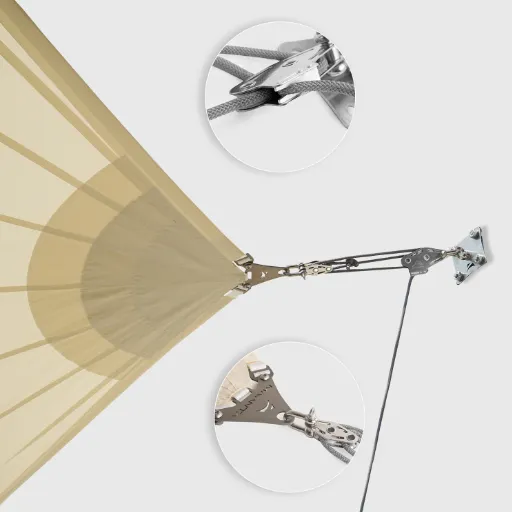
Installation Procedure – Step by Step
Step 1: Tarp Measurement Determinations
Measure the area for coverage in exact dimensions and give allowances for tensioning or overlapping during installation to fit the tarp tightly without large gaps or actual sagging, which can compromise performance.
Step 2: Selection of Anchor Points
Choose stable and durable anchor points such as a post, wall, or overhead beam. If the area is large, you may have to install poles or a suitable structure to bear the weight and tension of the shade tarp, especially during strong winds.
Step 3: Installation of Mounting Hardware
Attach your tarp with heavy-duty fixtures such as eye bolts, tensioning devices, or turnbuckles. Stainless steel and galvanized fittings are preferred because they resist corrosion or destroy by environmental stresses.
Step 4: Secure the Tarpaulin
Use heavy-duty ropes and bungees resistant to ultraviolet rays to secure the tarp to the mounting hardware. Start by securing one corner, applying as much tension as evenly possible to the other three corners to avoid concentration of stresses; then adjust the angles to the sun position for the best shade effect.
Step 5: Adjust Tension and Position
Adjust the tensioning devices till an appropriately tight fit-free of wrinkles appear on the tarp surface. Avoid over-tensioning, as this could overstretch the tarp or damage the anchor points by transferring force. Inspect occasionally to realign if necessary and test for stability by exerting mild pressure against the tarp.
Step 6: Safety and Final Check
After the installation and setting are complete, check for points with proper security and structural integrity. Check to make sure the hardware in all areas has been fastened securely and that none of the materials are being pulled down. Also, ensure the tarp is not sagging to an unacceptable level for it may pool water when it rains hard or cause increased tension.
The data extracted from recent search engines depict that maintenance after installation remains a step equally crucial for extended usability. Frequently, users ask if tarps should be taken down amid harsh twists of weather. It is recommended that the tarpaulin be taken down if there comes a warning of high winds or a predicted storm, for such conditions hugely augment the chance of damage to the material, as well as design-wise. By making inspections after every extreme weather event, one would greatly curb the probability of costly repair or replacement from that point on.
Securing Your Tarp: Grommets and Ties
Grommets and ties guarantee that the tarp is well secured and held against different environmental stresses. The grommets are an extra reinforcement of holes along the edges of a tarp either of metal or sturdy plastic, providing points of attachment to the tarp. The distribution of tension equally across the material prevents tearing. Tying the grommets with strong, weather-resistant ties such as bungee cords, rope, or zip ties will keep the tarp tight and secure even under moderate wind.
According to the recent data compiled from search engine queries, users often ask about the optimal spacing of the grommets and the type of ties most suitable to secure a tarp in a high-stress environment. Research and user suggestions indicate grommets should be spaced anywhere between 18 and 24 inches so as to have even tension without jeopardizing the integrity of the tarp. Great bungees, in fact, are suggested by countless users as the best type of ties because the elasticity of the bungees complements tension absorption, thereby lessening the strain against the grommets during strong winds. Following all this, in combination with regular tension checks, will greatly improve tarp performance and longevity.
Maintenance Tips for a Longer Life
Maximizing the tarp’s lifespan and overall performance can only be attained through following a set maintenance procedure. The first activity in the maintenance procedure is to regularly check the fabric for wear signs, such as fraying along the edges, weak grommets, and punctures in the material. Any such damaged area has to be immediately serviced through patching with adhesives or tarp tape, welded to the specific material type of your tarp, so as to stop further deterioration.
In addition, proper storage practices need to be put into consideration and taken care of. It could never get better: when not in action, keep the tarp clean by using mild soap and water to remove dust, mold, or residues that may yet further weaken the fabric if allowed to accumulate with time. Post-cleaning, the tarp should be dried completely to avoid mildew or material breakdown that can also set during storage if it is kept in damp conditions. Fold the tarp in such a manner that it follows its original creases for best ongoing structural integrity and then place the tarp in a cool-dry place away from direct sunlight or extremes in temperature ect.
Lastly, capitalizing on the latest search data putting emphasis on eco-friendly ways, the routine rotation of a tarp with constant exposure to the open can greatly prolong its life. So, through periodic switching of tarps, users can rule out all-exposing UV rays and harsh weather from focusing wear on any single one. All of these detailed maintenance practices implemented properly thus keep the tarp’s function intact while saving frequent replacement investments on this front and, for that matter, environment awareness.
Frequently Asked Questions (FAQ)
How Are Mesh Shade Tarps Different in Their Sun-Protecting Ability?
Mesh shade tarps provide shade and airflow simultaneously, which makes them suitable for patios and gardens where you want to block out majority of the sunlight without fully enclosing the area. The cloth used for these tarps blocks UV rays, letting through those harmful rays, and provides some level of cooling underneath. In most cases, mesh shade tarps are equipped with grommets or webbing to facilitate easy hanging. They also come in all sorts of colors and sizes, so matching your tarp to your outdoor decor or personal taste shouldn’t be hard.
Size Determination for Shade Tarp: What Should I Take Into Consideration?
When considering what size to purchase for your shade tarp, consider the dimension of land that has to be covered and the nature of the usage. Measure the area in dimensions within which you intend to install the tarp, be it a yard, patio, or pool area. The more shade protection should also be the consideration. Larger might mean more coverage but could be tricky to install. The perimeter of the tarp has to be a point of concern as well; make sure it will allow for secure fastening with either ties or grommets. Should you want something unusual, many suppliers tout their services of custom sizing so as to meet your very own demands.
Is a Shade Tarp Something That Can Be Used for Privacy?
Cutouts are adaptable for shade tarps, and similarly, shade tarps can also be less necessary as a privacy barrier. Block the view with a denser-weave or solid-fabric mesh shade tarp, and yet it lets through a little sunlight. A very useful tool for gardens and backyard situations in which one would rather be naked in an outdoor setting. There are many versions of heavy-duty privacy tarps in a host of colors to compliment your outdoor decor all while keeping you safe from sight. Just make sure that the shade tarp is going to be well installed around the whole perimeter.
From What Are Shade Tarps Usually Made?
Shade tarps are commonly made from polypropylene, polyethylene, or heavy-duty fabric. These materials provide durability and tear resistance, making them suitable for outdoor applications. The UV-resistant ones further help do away with disintegration due to sun exposure. Furthermore, many tarps have reinforced edges or webbing for extra amplification of strength and stability. When choosing a material, think about weight, resistance to weather conditions, and whether it’s easy to clean and maintain.
How Can I Make Sure That My Shade Tarp Is Installed Securely?
To secure installation of the shade tarp, begin by choosing a good location for installation and measuring the distance within. Fasten the tarp around the perimeter using strong ties or ropes and leaving it tight enough to withstand the wind. If your tarp has grommets, use them to anchor the tarp for further stability either to poles or other structures. For safety’s sake, go for reinforced edge tarps as they are made to resist tearing thus providing a more secure install. Check the tarp for wear and tear regularly to ascertain that it presents a safe and effective installation.
Reference Sources
Extreme Heat: Why Shade Matters for Livestock
This article from Michigan State University discusses the importance of shade, including tarps, in reducing temperatures for livestock.
Shade Tarps Over Tents
A detailed guide on using shade tarps for camping, focusing on their effectiveness in windy and sunny conditions.
Tarping, Solarization, and Occultation
This resource from the University of Vermont explains the use of tarps in agriculture, including solarization and soil management.

